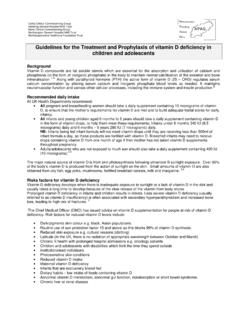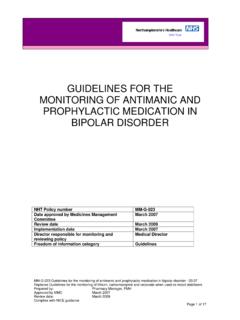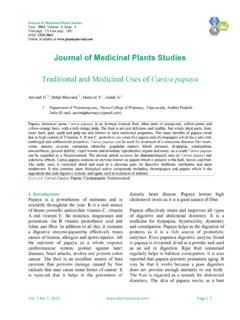Transcription of Guidelines for the Treatment of Vitamin D …
1 Approved by the Northamptonshire Prescribing Advisory Group June 2012 Review date June 2014 Guidelines for the Treatment of Vitamin D Deficiency and Insufficiency in Adults This document clarifies NHS Northamptonshire s position on the management of Vitamin D deficiency and prescribing of Vitamin D preparations in primary care. This is a an interim statement pending the findings of the Scientific Advisory Committee on Nutrition, which is currently reviewing the evidence base for Vitamin D deficiency and Treatment . The findings of this review could influence future prescribing policy, and is due to report in 2014. This Northamptonshire position statement on Vitamin D has been developed using the following key guidance: Consensus Vitamin D Position Statement.
2 Cancer Research UK, British Association of Dermatologists, Diabetes UK, the Multiple Sclerosis Society, the National Heart Forum, the National Osteoporosis Society and the Primary Care Dermatology Society. December 2010 [1] Update on Vitamin D. Position Statement by the Scientific Advisory Committee on Nutrition 2007 [2] Diagnosis and management of Vitamin D. BMJ 2010; 340: 142 147. 1. Testing for Vitamin D Deficiency Populations at high risk of Vitamin D deficiency include those listed in the CMO letter (see section 3) UK CMO CAS Letter Vitamin D Additional high risk patients where Vitamin D measurement should be considered include those with the following - intestinal malabsorption, for example coeliac disease, Crohn s disease, gastrectomy liver or renal disease taking medications including anticonvulsants, cholestyramine, rifampicin, glucocorticoids, antiretrovirals, IV bisphosphonates osteoporosis falls Vitamin D deficiency should be considered and checked in any patient with the following symptoms, and particularly in those at high risk of deficiency (above)
3 - one or more of the following clinical features: Insidious onset of widespread or localised bone pain and tenderness (especially lower back and hip pain, but may include rib, thigh or foot pain) proximal muscle weakness in quadriceps and glutei. This may cause difficulty rising from a chair and/ or a waddling gait swelling, tenderness and redness at pseudo fracture sites Approved by the Northamptonshire Prescribing Advisory Group June 2012 Review date June 2014 fractures, typically femoral neck, scapula, pubic rami, ribs or vertebrae non specific myalgia especially with a raised Creatine Kinase (CK) AND Other causes for symptoms have been excluded, for example myeloma, rheumatoid arthritis, polymyalgia rheumatica and hypothyroidism.
4 2. Should Vitamin D be prescribed on the NHS or purchased over-the-counter? For deficiency (< 25nmol/l) Vitamin D should be prescribed Prescribing of high dose Vitamin D should be offered only to individuals with Vitamin D deficiency levels <25nmol/l. High dose Vitamin D for Treatment of Vitamin D deficiency can be initiated in primary care. Prescribing for deficiency in primary care should be for Fultium-D3 800IU capsules, 4 daily for 84 days (12 weeks). Any secondary care prescribing will be for D3-50 50,000 IU tablets, one oral daily for 6 days sourced from Maudsley (special). Alternatively Colecalciferol 300,000 units IM injection, one monthly for 3 months will be used for patients unable to take or absorb oral replacement For maintenance following Treatment of deficiency Vitamin D should be prescribed Once patients have been treated, maintenance will be required.
5 Patients with previous deficiency are at high risk of becoming deficient again without maintenance Treatment . Suitable products can be selected from the flowchart at appendix1depending on the patient s calcium intake and can be prescribed on FP10. For insufficiency (25-50nmol/l) Vitamin D should be purchased OTC People with Vitamin D insufficiency (25-50nmol/l) should be advised to purchase these products OTC. Suitable products can be selected from the flowchart at appendix 1 depending on the patient s calcium intake and should be purchased over-the-counter. A variety of other Vitamin D supplements, such as Sunvit D3, are also available from pharmacies and health food shops. For people identified as at risk by the Chief Medical Officers (CMO) Vitamin D can be supplied free of charge under the Healthy Start scheme (see below) or purchased OTC.
6 Approved by the Northamptonshire Prescribing Advisory Group June 2012 Review date June 2014 3. CMO Advice on supplements for at risk groups The Chief Medical Officers of England, Scotland, Wales and Northern Ireland wrote to healthcare professionals in February 2012 highlighting the issue of Vitamin D deficiency and identifying at risk groups. See UK CMO CAS Letter Vitamin D The following groups of people are identified as at risk of Vitamin D deficiency by the CMO - All pregnant and breastfeeding women, especially teenagers and young women. Infants and young children under 5 years of age. Older people aged 65 years and over. People who have low or no exposure to the sun, for example those who cover their skin for cultural reasons, who are housebound or confined indoors for long periods.
7 People who have darker skin, for example people of African, African-Caribbean and South Asian origin, because their bodies are not able to make as much Vitamin D. All UK Health Departments recommend: All pregnant and breastfeeding women should take a daily supplement containing 10 micrograms of Vitamin D, to ensure the mother s requirements for Vitamin D are met and to build adequate fetal stores for early infancy. All infants and young children aged 6 months to 5 years should take a daily supplement containing Vitamin D in the form of Vitamin drops, to help them meet the requirement set for this age group of micrograms of Vitamin D per day. However, those infants who are fed infant formula will not need Vitamin drops until they are receiving less than 500ml of infant formula a day, as these products are fortified with Vitamin D.
8 Breastfed infants may need to receive drops containing Vitamin D from one month of age if their mother has not taken Vitamin D supplements throughout pregnancy. People aged 65 years and over and people who are not exposed to much sun should also take a daily supplement containing 10 micrograms of Vitamin D. 4. Healthy Start Vitamin supplements Women and children from families who are eligible for the Government s Healthy Start scheme can get free Vitamin supplements which include Vitamin D, in the form of tablets for women and drops for children. Health professionals should familiarise themselves with local distribution arrangements for Healthy Start vitamins. Approved by the Northamptonshire Prescribing Advisory Group June 2012 Review date June 2014 Outlets supplying Healthy Start vitamins can be identified by inserting the appropriate postcode via this link - It is important that women and families who may be eligible for Healthy Start know how they can apply for the scheme, and are made aware of how they can obtain vitamins locally.
9 Women qualify for Healthy Start from the 10th week of pregnancy or if they have a child under four years old, and if she or her family receive: Income Support, or Income-based Jobseeker s Allowance, or Income-related Employment and Support Allowance, or Child Tax Credit (but not Working Tax Credit unless the family is receiving Working Tax Credit run-on only) and has an annual family income of 16,190 or less. Women who are under 18 and pregnant also qualify, even if they do not get any of the above benefits or tax credits. Further information can be found on the Healthy Start website at 5. Patient lifestyle advice and information For those at higher risk of Vitamin D deficiency it is important to know that small changes in lifestyle can significantly reduce the risk of ill health.
10 Exposure to the sun is a physiologically apt way of improving Vitamin D levels. This should be balanced against the risks of excessive exposure however the time required in the sun to make sufficient Vitamin D is generally short and less than the time needed for skin to burn, sun exposure should be adjusted on an individual basis and safe practices adopted. As a general rule in the UK exposing the face and arms to the sun for about 15 minutes around midday three times a week from March to September should be beneficial. During the winter months the sun does not produce enough Ultraviolet B radiation to cause any significant production of Vitamin D in the skin. There are several sources of additional support for individuals wishing to make lifestyle changes in order to improve Vitamin D intake: General sources of information The NHS Choices website includes information on dietary sources of Vitamin D and government recommendations for at risk groups and can be found at: Approved by the Northamptonshire Prescribing Advisory Group June 2012 Review date June 2014 Local support and information Health Trainers Health Trainers provide a free and confidential service made up of local people who are trained to offer one to one support to help people to reach a personal goal to improve your health and wellbeing.













